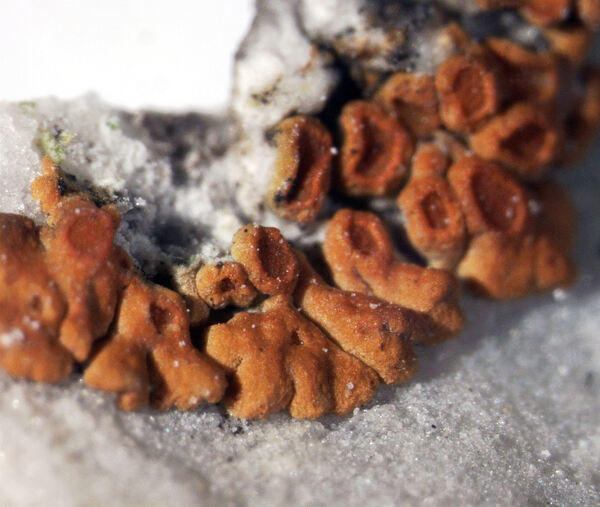Calogaya miniata (Hoffm.) Wilk & Lücking
Mycotaxon, 136, 2: 393, 2021. Basionym: Psora miniata Hoffm. - Enum. Lich.: 63, 1784
Synonyms: Amphiloma pusillum var. miniatum (Hoffm.) Bagl.; Caloplaca miniata (Hoffm.) Jatta; Caloplaca murorum f. miniata (Hoffm.) Ozenda & Clauzade; Caloplaca pusilla var. miniata (Hoffm.) Jatta; Caloplaca rouxii Gaya, Nav.-Ros. & Llimona; Gasparrinia murorum f. miniata (Hoffm.) Dalla Torre & Sarnth.; Lecanora miniata (Hoffm.) Ach.; Physcia murorum var. miniata (Hoffm.) Arnold; Physcia pusilla var. miniata (Hoffm.) Arnold; Placodium pusillum var. miniatum (Hoffm.) Anzi
Distribution: N - Frl, Ven (Nascimbene & Caniglia 2000, 2003c, Nascimbene 2008c), TAA (Nascimbene & al. 2006, 2022, Nascimbene 2008b), Lomb (Anzi 1860), Piem (Nascimbene & al. 2021), Lig (Jatta 1909-1911). C - Tosc (Jatta 1909-1911), Laz (Jatta 1909-1911), Abr (Nimis & Tretiach 1999, Gheza & al. 2021).
Description: Thallus crustose-placodioid, episubstratic, rather loosely attached, bright scarlet red or orange-red, epruinose, usually with discoloured patches resembling pseudocyphellae, forming orbicular, up to 1.2 cm wide rosettes. Marginal lobes up to 1.2 mm long, strongly convex, contiguous to overlapping; central parts of thallus of flat, angular areoles. Cortex prosoplectenchymatous, 30-80 µm thick, with hyphal cells perpendicular to the surface, and partially reaching the algal layer. Apothecia numerous, covering the base of lobes, 0.3-1.2(-1.8) mm across, at first immersed in the thallus, then adnate to broadly sessile, round to irregular in outline by mutual compression, with a concave to finally slightly convex, scarlet red to red-orange, epruinose disc, a thin, paler proper margin, and a smooth to crenulate thalline margin concolorous to thallus. Epithecium 6-14 µm thick, brownish yellow, K+ purple-red; hymenium colourless, 50-95 µm high; paraphyses richly branched, 1.5-3.5 µm thick at base, the apical cells 3-6.5 µm wide; hypothecium colourless. Asci 8-spored, clavate, functionally unitunicate, apically thickened with a broad internal beak, the inner part of apex and external cap I+ blue, Teloschistes-type. Ascospores 2-celled, polarilocular, hyaline, narrowly ellipsoid, (10-)11.5-15(16.5) x (3.5-)5-6(-7), the equatorial thickening (“septum”) (2.5-)3.5-5(-6) µm. Photobiont chlorococcoid. Spot tests: thallus and apothecia K+ purple-red, C-, KC-, P-. Chemistry: thallus and apothecia with unidentified anthraquinones.Note: a species with an Alpine distribution, growing mainly on the top of calcareous boulders in sunny and nutrient-enriched sites, often with C. biatorina and Rusavskia elegans. The species was frequently confused with C. arnoldii, but is widespread throughout the calcareous Alps, and also occurs in the Central Apennines.
Growth form: Crustose
Substrata: rocks
Photobiont: green algae other than Trentepohlia
Reproductive strategy: mainly sexual
Commonnes-rarity: (info)
Alpine belt: rather common
Subalpine belt: rather rare
Oromediterranean belt: rare
Montane belt: very rare
Submediterranean belt: absent
Padanian area: absent
Humid submediterranean belt: absent
Humid mediterranean belt: absent
Dry mediterranean belt: absent
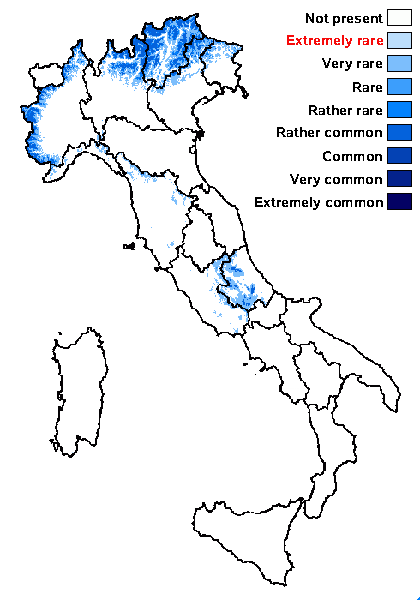
Predictive model
Herbarium samples
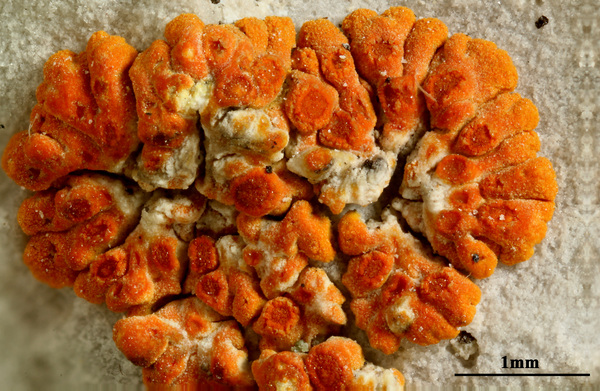

Felix Schumm - CC BY-SA 4.0
[19567], Austria, Styria, Hochschwab montium Alpium, in monte Griesmauer, alt. 1750 m, in rupibus calcareis. Leg. J. Poelt & A. Vezda, 19.09.1982. VEZDA: LICHENES SELECTI EXSICCATI NR. 1862.
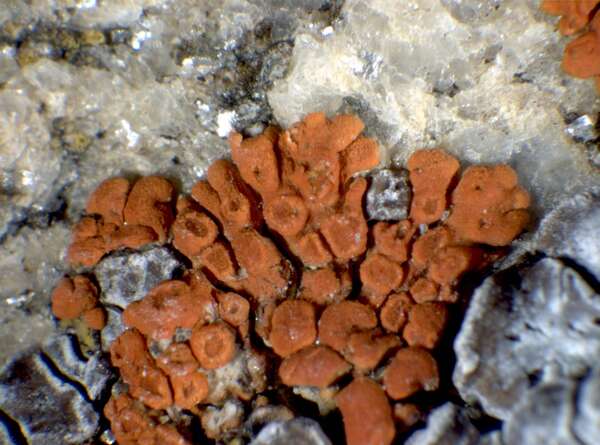

P.L. Nimis; Owner: Department of Life Sciences, University of Trieste
Herbarium: TSB (32977)
2001/12/04
As Caloplaca arnoldii
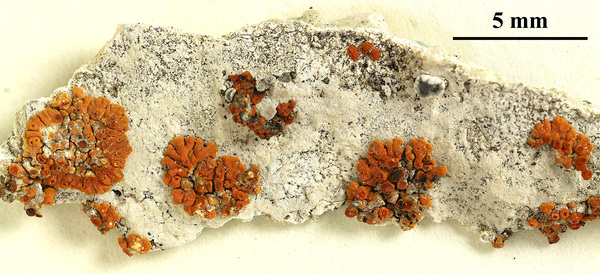

Felix Schumm - CC BY-SA 4.0
[19567], Austria, Styria, Hochschwab montium Alpium, in monte Griesmauer, alt. 1750 m, in rupibus calcareis. Leg. J. Poelt & A. Vezda, 19.09.1982. VEZDA: LICHENES SELECTI EXSICCATI NR. 1862.


Felix Schumm - CC BY-SA 4.0
[19567], Austria, Styria, Hochschwab montium Alpium, in monte Griesmauer, alt. 1750 m, in rupibus calcareis. Leg. J. Poelt & A. Vezda, 19.09.1982. VEZDA: LICHENES SELECTI EXSICCATI NR. 1862.
AS Caloplaca arnoldii


P.L. Nimis; Owner: Department of Life Sciences, University of Trieste
Herbarium: TSB (32977)
2001/11/19


Felix Schumm - CC BY-SA 4.0
[19567], Austria, Styria, Hochschwab montium Alpium, in monte Griesmauer, alt. 1750 m, in rupibus calcareis. Leg. J. Poelt & A. Vezda, 19.09.1982. VEZDA: LICHENES SELECTI EXSICCATI NR. 1862.
AS Caloplaca arnoldii
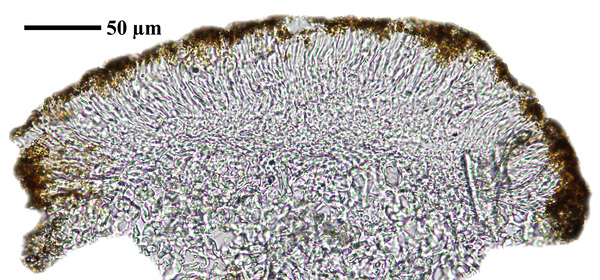

Felix Schumm; Owner: Felix Schumm - CC BY-SA 4.0
[19567], Austria, Styria, Hochschwab montium Alpium, in monte Griesmauer, alt. 1750 m, in rupibus calcareis. Leg. J. Poelt & A. Vezda, 19.09.1982. VEZDA: LICHENES SELECTI EXSICCATI NR. 1862.
AS Caloplaca arnoldii
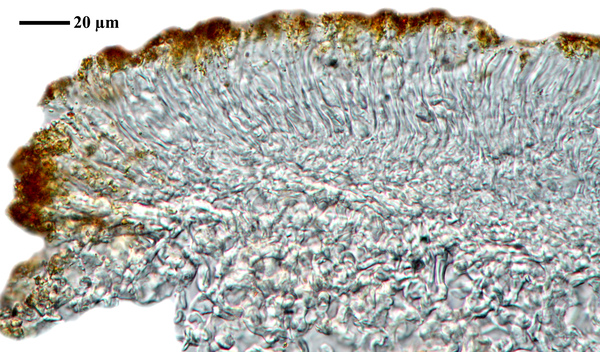

Felix Schumm; Owner: Felix Schumm - CC BY-SA 4.0
[19567], Austria, Styria, Hochschwab montium Alpium, in monte Griesmauer, alt. 1750 m, in rupibus calcareis. Leg. J. Poelt & A. Vezda, 19.09.1982. VEZDA: LICHENES SELECTI EXSICCATI NR. 1862.
AS Caloplaca arnoldii
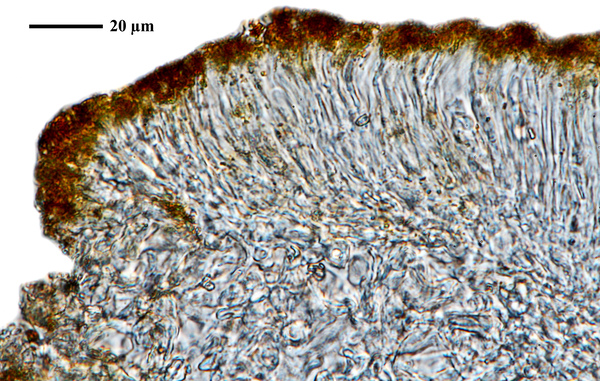

Felix Schumm; Owner: Felix Schumm - CC BY-SA 4.0
[19567], Austria, Styria, Hochschwab montium Alpium, in monte Griesmauer, alt. 1750 m, in rupibus calcareis. Leg. J. Poelt & A. Vezda, 19.09.1982. VEZDA: LICHENES SELECTI EXSICCATI NR. 1862.
AS Caloplaca arnoldii
Growth form: Crustose
Substrata: rocks
Photobiont: green algae other than Trentepohlia
Reproductive strategy: mainly sexual
Commonnes-rarity: (info)
Alpine belt: rather common
Subalpine belt: rather rare
Oromediterranean belt: rare
Montane belt: very rare
Submediterranean belt: absent
Padanian area: absent
Humid submediterranean belt: absent
Humid mediterranean belt: absent
Dry mediterranean belt: absent

Predictive model
| Herbarium samples |


Felix Schumm - CC BY-SA 4.0
[19567], Austria, Styria, Hochschwab montium Alpium, in monte Griesmauer, alt. 1750 m, in rupibus calcareis. Leg. J. Poelt & A. Vezda, 19.09.1982. VEZDA: LICHENES SELECTI EXSICCATI NR. 1862.


P.L. Nimis; Owner: Department of Life Sciences, University of Trieste
Herbarium: TSB (32977)
2001/12/04
As Caloplaca arnoldii


Felix Schumm - CC BY-SA 4.0
[19567], Austria, Styria, Hochschwab montium Alpium, in monte Griesmauer, alt. 1750 m, in rupibus calcareis. Leg. J. Poelt & A. Vezda, 19.09.1982. VEZDA: LICHENES SELECTI EXSICCATI NR. 1862.


Felix Schumm - CC BY-SA 4.0
[19567], Austria, Styria, Hochschwab montium Alpium, in monte Griesmauer, alt. 1750 m, in rupibus calcareis. Leg. J. Poelt & A. Vezda, 19.09.1982. VEZDA: LICHENES SELECTI EXSICCATI NR. 1862.
AS Caloplaca arnoldii


P.L. Nimis; Owner: Department of Life Sciences, University of Trieste
Herbarium: TSB (32977)
2001/11/19


Felix Schumm - CC BY-SA 4.0
[19567], Austria, Styria, Hochschwab montium Alpium, in monte Griesmauer, alt. 1750 m, in rupibus calcareis. Leg. J. Poelt & A. Vezda, 19.09.1982. VEZDA: LICHENES SELECTI EXSICCATI NR. 1862.
AS Caloplaca arnoldii


Felix Schumm; Owner: Felix Schumm - CC BY-SA 4.0
[19567], Austria, Styria, Hochschwab montium Alpium, in monte Griesmauer, alt. 1750 m, in rupibus calcareis. Leg. J. Poelt & A. Vezda, 19.09.1982. VEZDA: LICHENES SELECTI EXSICCATI NR. 1862.
AS Caloplaca arnoldii


Felix Schumm; Owner: Felix Schumm - CC BY-SA 4.0
[19567], Austria, Styria, Hochschwab montium Alpium, in monte Griesmauer, alt. 1750 m, in rupibus calcareis. Leg. J. Poelt & A. Vezda, 19.09.1982. VEZDA: LICHENES SELECTI EXSICCATI NR. 1862.
AS Caloplaca arnoldii


 DOLICHENS
DOLICHENS

